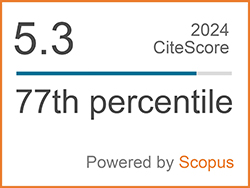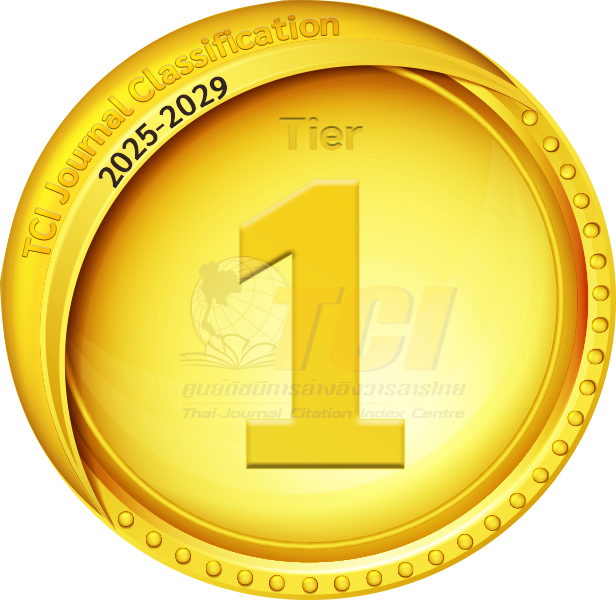Reduction of Carbonaceous and Nitrogenous Disinfection Byproduct Precursors from Coagulated/Filtered Algae-laden Water: Comparison of Vacuum Ultraviolet and Ultraviolet Processes with and without Persulfate Activation
Abstract
Keywords
[1] R. Connor, The United Nations World Water Development Report 2024: water for prosperity and peace; executive summary, UNESCO World Water Assessment Programme. France: UNESCO, Mar. 2024.
[2] T. Somdee, T. Kaewsan, and A. Somdee, “Monitoring toxic cyanobacteria and cyanotoxins (microcystins and cylindrospermopsins) in four recreational reservoirs (Khon Kaen, Thailand),” Environmental Monitoring and Assessment, vol. 185, pp. 9521–9529, 2013, doi: 10.1007/s10661-013-3270-8.
[3] M. Schneider and L. Bláha, “Advanced oxidation processes for the removal of cyanobacterial toxins from drinking water,” Environmental Sciences Europe, vol. 32, pp. 1–15, 2020, doi: 10.1186/s12302-020-00371-0.
[4] F. Dong, Q. Lin, C. Li, G. He, and Y. Deng, “Impacts of pre-oxidation on the formation of disinfection byproducts from algal organic matter in subsequent chlor(am)ination: A review,” Science of the Total Environment, vol. 754, pp. 1–15, 2021, doi: 10.1016/j.scitotenv. 2020.141955.
[5] X. Li, N. R. H. Rao, K. L. Linge, C. A. Joll, S. Khan, and R. K. Henderson, “Formation of algal-derived nitrogenous disinfection by-products during chlorination and chloramination,” Water Research, vol. 183, pp. 1–10, 2020, doi: 10.1016/j.watres.2020.116047.
[6] Y. Chen et al., “UV-assisted chlorination of algae-laden water: Cell lysis and disinfection byproducts formation,” Chemical Engineering Journal, vol. 383, 2020, Art. no. 123165, doi: 10.1016/j.cej.2019.123165.
[7] K. Foreman et al., “Effects of harmful algal blooms on regulated disinfection byproducts: Findings from five utility case studies,” AWWA Water Science, vol. 3, pp. 1–21, 2021, doi: 10.1002/aws2.1223.
[8] P. Kiattisaksiri, E. Khan, P. Punyapalakul, C. Musikavong, D. C. W. Tsang, and T. Ratpukdi, “Vacuum ultraviolet irradiation for mitigating dissolved organic nitrogen and formation of haloacetonitriles,” Environmental Research, vol. 185, 2020, Art. no. 109454, doi: 10.1016/ j.envres.2020.109454.
[9] Y. Zhang, W. Chu, D. Yao, and D. Yin, “Control of aliphatic halogenated DBP precursors with multiple drinking water treatment processes: Formation potential and integrated toxicity,” Journal of Environmental Sciences, vol. 58, pp. 322–330, 2017, doi: 10.1016/j.jes.2017.03.028.
[10] J. Ma et al., “Enhanced coagulation of covalent composite coagulant with potassium permanganate oxidation for algae laden water treatment: Algae and extracellular organic matter removal,” Chemical Engineering Journal Advances, vol. 13, Art. no. 100427, 2023, doi: 10.1016/j.ceja. 2022.100427.
[11] X. Lei, Y. Lei, X. Zhang, and X. Yang, “Treating disinfection byproducts with UV or solar irradiation and in UV advanced oxidation processes: A review,” Journal of Hazardous Materials, vol. 408, 2021, Art. no. 124435, doi: 10.1016/j.jhazmat.2020.124435.
[12] Y. L. Zhang et al., “Promotive effects of vacuum-UV/UV (185/254 nm) light on elimination of recalcitrant trace organic contaminants by UV-AOPs during wastewater treatment and reclamation: A review,” Science of the Total Environment, vol. 818, 2022, Art. no. 151776, doi: 10.1016/j.scitotenv.2021.151776.
[13] Y. Murata, H. Sakai, and K. Kosaka, “Degrading surface-water-based natural organic matter and mitigating haloacetonitrile formation during chlorination: Comparison of UV/persulfate and UV/hydrogen peroxide pre-treatments,” Chemosphere, vol. 354, 2024, Art. no. 141717, doi: 10.1016/ j.chemosphere.2024.141717.
[14] F. Zhang and M. Sui, “Progress of persulfate-based advanced oxidation process (PS-AOPs) coupled with ultrafiltration membrane to alleviate membrane fouling: A review,” Environmental Engineering Research, vol. 30, 2024, Art. no. 240244, doi: 10.4491/eer.2024.244.
[15] F. Dong, Q. Lin, J. Deng, T. Zhang, C. Li, and X. Zai, “Impact of UV irradiation on Chlorella sp. damage and disinfection byproducts formation during subsequent chlorination of algal organic matter,” Science of the Total Environment, vol. 671, pp. 519–527, 2019, doi: 10.1016/j.scitotenv.2019.03.282.
[16] D. Wen, W. Li, J. Lv, Z. Qiang, and M. Li, “Methylene blue degradation by the VUV/UV/persulfate process: Effect of pH on the roles of photolysis and oxidation,” Journal of Hazardous Materials, vol. 391, 2020, Art. no. 121855, doi: 10.1016/j.jhazmat.2019.121855.
[17] W. Chu, D. Li, Y. Deng, N. Gao, Y. Zhang, and Y. Zhu, “Effects of UV/PS and UV/H2O2 pre-oxidations on the formation of trihalomethanes and haloacetonitriles during chlorination and chloramination of free amino acids and short oligopeptides,” Chemical Engineering Journal, vol. 301, pp. 65–72, 2016, doi: 10.1016/j.cej. 2016.04.003.
[18] H. Zhang, W. Sun, J. Zhang, and J. Ma, “Vacuum-ultraviolet based advanced oxidation and reduction processes for water treatment,” Journal of Hazardous Materials, vol. 471, 2024, Art. no. 134432, doi: 10.1016/j.jhazmat.2024. 134432.
[19] P. Kiattisaksiri, N. Petmark, and T. Ratpukdi, “Combination of coagulation and VUV+H2O2 for the treatment of color and organic matter in treated effluent wastewater from a sugar factory,” Applied Science and Engineering Progress, vol. 16, no. 4, p. 6192, 2023, doi: 10.14416/j.asep.2022.08.002.
[20] P. Kiattisaksiri, E. Khan, P. Punyapalakul, and T. Ratpukdi, “Photodegradation of haloacetonitriles in water by vacuum ultraviolet irradiation: Mechanisms and intermediate formation,” Water Research, vol. 98, pp. 160–167, 2016, doi: 10.1016/j.watres.2016.04.010.
[21] N. Ranthom, W. Khongnakorn, and P. Jutaporn, “MIEX resin and enhanced coagulation treatment of high-bromide natural water: Chlorine reactivity and DBP precursors removal,” Journal of Environmental Chemical Engineering, vol. 11, 2023, Art. no. 111497, doi: 10.1016/j.jece.2023. 111497.
[22] Z. Amiri, G. Moussavi, S. Mohammadi, and S. Giannakis, “Development of a VUV-UVC/ peroxymonosulfate, continuous-flow advanced oxidation process for surface water disinfection and natural organic matter elimination: Application and mechanistic aspects,” Journal of Hazardous Materials, vol. 408, 2021, Art. no. 124634, doi: 10.1016/j.jhazmat.2020.124634.
[23] H. W. Chen, C. Y. Chen, and G. S. Wang, “Performance evaluation of the UV/H2O2 process on selected nitrogenous organic compounds: Reductions of organic contents vs. corresponding C-, N-DBPs formations,” Chemosphere, vol. 85, no. 4, pp. 591–597, 2011.
[24] B. Li, F. Yang, B. Chen, J. Li, L. Zhu, and W. T. Li, “Detecting trace dissolved organic nitrogen (DON) in freshwater by converting DON rapidly into nitrate with VUV/H2O2 pretreatment,” Chemosphere, vol. 307, 2022, Art. no. 135790, doi: 10.1016/j.chemosphere.2022.135790.
[25] P. G. Coble, “Characterization of marine and terrestrial DOM in seawater using excitation-emission matrix spectroscopy,” Marine Chemistry, vol. 51, pp. 325–346, 1996, doi: 10.1016/0304-4203(95)00062-3.
[26] M. P. Miller, D. M. McKnight, and S. C. Chapra, “Production of microbially-derived fulvic acid from photolysis of quinone-containing extracellular products of phytoplankton,” Aquatic Sciences, vol. 71, pp. 170–178, 2009, doi: 10.1007/ s00027-009-9194-2.
[27] G. Ji et al., “Study on the removal of humic acid by ultraviolet/persulfate advanced oxidation technology,” Environmental Science and Pollution Research, vol. 27, pp. 26079–26090, 2020, doi: 10.1007/s11356-020-08894-y.
[28] X. Li et al., “Molecular transformation of dissolved organic matter during persulfate-based advanced oxidation: Response of reaction pathways to structure,” Chemical Engineering Journal, vol. 474, 2023, Art. no. 146256, doi: 10.1016/j.cej.2023.146256.
[29] P. Jutaporn, M. D. Armstrong, and O. Coronell, “Assessment of C-DBP and N-DBP formation potential and its reduction by MIEX® DOC and MIEX® GOLD resins using fluorescence spectroscopy and parallel factor analysis,” Water Research, vol. 172, 2020, Art. no. 115460, doi: 10.1016/j.watres.2019.115460.
[30] R. J. P. Latiza, R. V. Rubi, and A. Quitain, “Supercritical water gasification for hospital wastewater,” Journal of Hazardous Materials Advances, 2025, Art. no. 100651, doi: 10.1016/ j.hazadv.2025.100651.
[31] M. Usman, M. Hüben, T. Kato, C. Zwiener, T. Wintgens, and V. Linnemann, “Occurrence of brominated disinfection by-products in thermal spas,” Science of the Total Environment, vol. 845, 2022, Art. no. 157338, doi: 10.1016/ j.scitotenv.2022.157338.
DOI: 10.14416/j.asep.2025.10.006
Refbacks
- There are currently no refbacks.
 Applied Science and Engineering Progress
Applied Science and Engineering Progress







